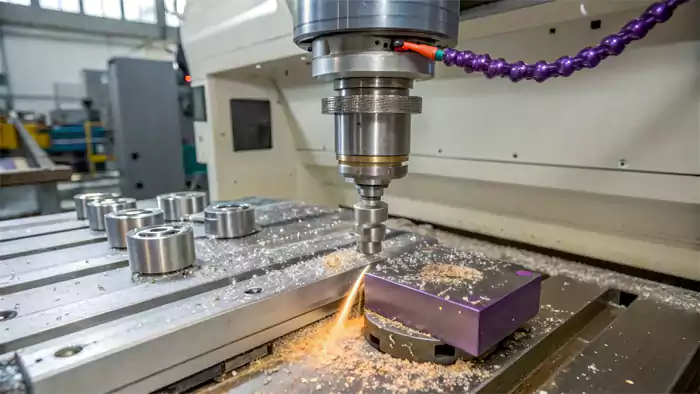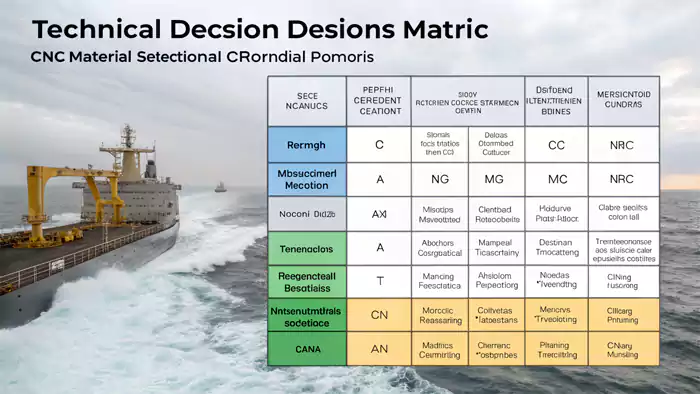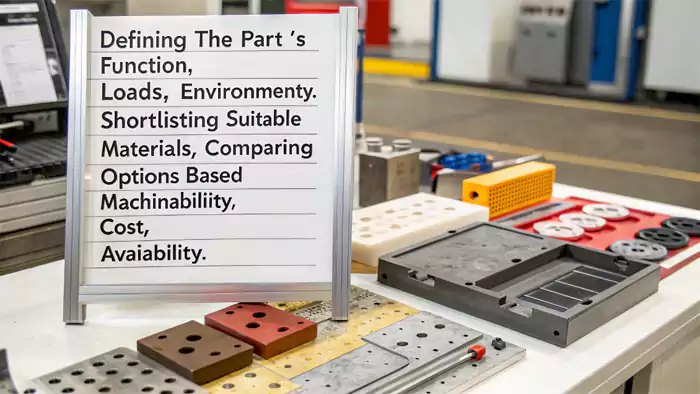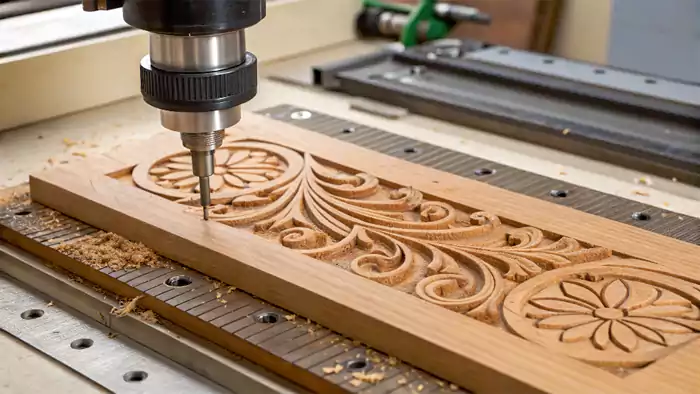Editor's Note: Last updated on 2025-10-17 09:58:11 Friday
Choosing the wrong material for your CNC project can lead to failures or unexpected costs. Are you stuck trying to figure out the best fit? Let's make the selection process easier.
Select your CNC material by balancing project needs (like strength and weight), environmental exposure (corrosion, temperature), budget constraints, and manufacturing factors like machinability. Aluminum is often a great starting point, while steels or plastics fit other specific needs.
Picking the right material is one of the most critical decisions you'll make for a custom part. It affects everything from how the part performs in its final application to how much it costs to produce. We need to think carefully about what the part needs to do. Let's explore the options and factors involved so you can choose with confidence.
What materials are suitable for CNC?
Wondering what your options actually are for CNC machining? Maybe you think the choices are limited? You might be surprised by the wide range of materials these machines can handle.
CNC machines work with many materials, including various metals (aluminum, steel, brass, titanium), plastics (ABS, Nylon, Polycarbonate, PEEK), woods, composites, and foams. The suitability depends entirely on the part's application and the specific CNC machine being used.

Let's dive deeper into the common categories. CNC machines are incredibly versatile.
Metals
This is often what people think of first.
We regularly machine Aluminum (like 6061 or 7075) because it's lightweight, corrosion-resistant, and relatively easy to machine, making it cost-effective.
Steels (carbon steel, alloy steel, tool steel) offer higher strength and durability. Stainless Steels (like 304 or 316) provide excellent corrosion resistance.
We also work with Brass for its electrical conductivity and appearance, and Titanium for high strength-to-weight ratio and biocompatibility, though it's tougher to machine.
I remember a client needing a part for a marine environment; stainless steel was the obvious choice despite the higher cost compared to aluminum.
Plastics
Engineering plastics are fantastic for many applications.
ABS is tough and impact-resistant, great for enclosures.
Polycarbonate1 is very strong and transparent.
Nylon offers good wear resistance.
Acetal (Delrin) has excellent machinability and dimensional stability, perfect for precision parts like gears.
High-performance plastics like PEEK2 handle extreme temperatures and chemicals. For someone like Jacky designing consumer electronics housings, ABS or Polycarbonate are often top contenders.
Other Materials
Beyond metals and plastics, CNC machines (especially routers) can handle Wood (hardwoods, softwoods, MDF) for furniture, prototypes, or decorative items.
Tooling Foam is used for creating molds or prototypes quickly. Even Composites like Carbon Fiber can be machined with specialized tooling and techniques. The key is matching the material's properties to the job.
Real-World Application: High-Temperature Sensor Housing
Here's a practical example from our shop that perfectly illustrates the material selection process in action:
We recently worked with a design engineer developing a sensor housing for industrial oven monitoring. The procurement manager needed 150 units with quick turnaround and strict performance specifications.
Part Requirements:
- Operating Temperature: 180°C continuous, 220°C peak
- Chemical Exposure: Mild acidic atmosphere
- Dimensional Stability: ±0.05mm over temperature range
- Mounting: 4x M4 threaded inserts
- EMI Shielding: Required for signal integrity
- Color: Black for laser marking
Material Selection Process:
Our production manager initially suggested aluminum 6061 with hard anodizing, but the thermal expansion and potential galvanic corrosion raised concerns. The design engineer then proposed stainless steel 316, but the higher cost and weight were problematic.
After reviewing material datasheets and consulting with our senior machinist, we recommended PEEK (Polyether Ether Ketone) with embedded stainless steel inserts.
Final Specifications & Results:
- Material: PEEK (natural) with Type 304 stainless steel threaded inserts
- Machining Process: 3-axis milling with secondary drilling/tapping operations
- Critical Tolerances: All mating surfaces held to ±0.03mm
- Surface Finish: 1.2μm Ra achieved as-machined
- Thermal Performance: Verified stable at 220°C for 72-hour continuous test
- Cost per Part: $18.50 (material + machining) - 35% lower than stainless steel alternative
- Lead Time: 3 weeks for full production run
The quality inspector noted that using carbide tooling with high-pressure coolant prevented delamination and maintained dimensional stability throughout the production run. This solution saved approximately $2,800 in material costs while meeting all performance requirements.
What factors should be taken into consideration when selecting stock for CNC machining?
Choosing the general material type is just the start. How do you narrow down the specific stock? Picking without considering all factors can cause headaches down the line.
Key factors include mechanical properties (strength, hardness), thermal behavior, corrosion resistance, weight, how easily it machines (machinability), required surface finish, and overall cost. You must weigh these against your part's function and operating environment.

Selecting the right stock involves looking closely at several characteristics.
Performance Needs
- Mechanical Properties: This is often the most critical. How strong does it need to be (tensile strength)? Does it need to resist scratching or wear (hardness)? Will it experience impacts (toughness) or repeated loads (fatigue strength3)? For Jacky designing a plastic clip, fatigue strength and flexibility are vital.
- Thermal Properties: Will the part get hot or cold? How much does it expand or contract with temperature changes? Does it need to conduct or insulate heat?
- Corrosion Resistance: Will it be exposed to moisture, chemicals, or salty air? Choosing a material like stainless steel or certain plastics might be necessary.
- Weight: Is weight a critical factor, like in aerospace or automotive parts? Aluminum and titanium, or plastics, are much lighter than steel.
Manufacturing and Cost
- Machinability: How easily can the material be cut? Harder materials or those that are 'gummy' take longer to machine, requiring slower speeds, special tools, and more machine time, which increases cost. I once had a project where specifying a very tough exotic alloy doubled the machining time compared to standard steel.
- Material Cost: Raw material prices vary significantly. Aluminum is generally affordable, while titanium or PEEK are expensive.
- Finish Requirements: Do you need a specific look or feel? Some materials naturally machine to a better finish than others or are easier to polish, anodize, or paint.
- Availability: Can you get the material easily in the size and shape (bar, plate) you need? Uncommon materials or sizes might have long lead times.
Here's a quick comparison:
| Factor | Aluminum 6061 | Stainless Steel 304 | Acetal (Delrin) |
|---|---|---|---|
| Strength | Medium | High | Medium |
| Corrosion Resist. | Good | Excellent | Good (Chemicals) |
| Weight | Low | High | Low |
| Machinability | Excellent | Fair | Excellent |
| Cost | Low | Medium | Low-Medium |
How to choose the right cnc machining material?
Feeling stuck navigating all these material options and factors? Need a clear path to make the final decision? A structured approach ensures you pick the best fit.
Define your part's essential needs first (function, loads, environment). Then, shortlist materials that meet these critical criteria. Finally, compare your options based on machinability, cost, and availability to make the optimal choice.

Let's walk through a logical process for choosing your material. It helps avoid guesswork.
Step 1: Define Critical Requirements
Before looking at materials, know exactly what your part must do.
- Function: What is its primary purpose? What forces or loads will it experience?
- Environment: What temperatures, chemicals, or moisture levels will it encounter?
- Lifespan: How long does it need to last?
- Key Properties: List the non-negotiables. Does it have to be lightweight? Does it need extreme heat resistance? What's the absolute maximum budget?
Step 2: Shortlist Potential Materials
With your requirements list, start identifying material families that fit. If high strength is key, look at steels, titanium, or stronger aluminum alloys. If corrosion resistance is paramount, consider stainless steels, brass, or specific plastics. Use online material databases or supplier datasheets to find candidates matching your must-haves. For Jacky, designing a mold core requires high compressive strength and thermal stability, pointing towards tool steels4.
Step 3: Compare the Candidates
Now, evaluate the shortlisted materials against secondary factors.
- Machinability: How does it compare? Easier machining means lower cost and faster turnaround.
- Cost: Compare the raw material cost per part.
- Availability: Is it readily available in the needed stock size?
- Finishing: Can it achieve the required surface finish easily?
Step 4: Consult and Decide
Don't hesitate to talk to experts. Discuss your shortlisted options with your machinist (like me at Allied Metal) or material suppliers. We have practical experience with how materials behave during machining and in real-world use. This input can be invaluable. Finally, make the decision that best balances performance, manufacturability, and cost for your specific application.
Which is the best material for CNC carving?
Planning to create detailed designs or artistic pieces with CNC? Are you wondering what machines best for intricate shapes? Material choice significantly impacts carving quality and ease.
For detailed CNC carving, softer materials are often best. Woods like Basswood or Pine, plastics like ABS or Acrylic, tooling foam, and softer metals like Aluminum or Brass allow fine detail capture without excessive tool wear or chipping.

"Carving" usually implies creating 3D shapes5, reliefs, and fine details, often using CNC routers6 rather than heavy-duty mills. The focus is often more on aesthetics or form than pure mechanical strength. The "best" material depends on the desired look and application.
Woods
- Softwoods: Basswood is a favorite for intricate carving because it has a fine, even grain and is very soft, minimizing chipping. Pine is also popular and readily available.
- Hardwoods: Maple or Cherry offer a more durable result with a beautiful finish but require sharper tools and potentially slower cutting speeds to avoid burning or tear-out.
- MDF (Medium-Density Fiberboard): Very consistent and stable, carves smoothly, but creates fine dust. Good for painted projects.
Plastics
- Acrylic (Plexiglas): Carves cleanly, often used for signs, lithophanes, or decorative items. Can be polished to transparency.
- ABS: A bit tougher than acrylic, good if the carved part needs some impact resistance.
- PVC Foam Board (Sintra, Komatex): Very lightweight and easy to carve, great for signs and displays.
Foams
- High-Density Urethane (HDU) / Tooling Foam: Excellent for highly detailed models, prototypes, and mold patterns. It carves very smoothly, holds sharp edges well, and doesn't have grain issues like wood. I sometimes use this for quick mold shape verification.
Metals
- Aluminum: The most commonly carved metal. It's relatively soft, machines cleanly, and allows for good detail.
- Brass: Also carves well and provides a classic, decorative look.
Harder metals like steel are generally not ideal for fine, artistic carving due to tool wear and difficulty achieving tiny details, though they can certainly be machined into complex shapes.
Conclusion
Choosing the right CNC material means defining your needs first. Consider strength, environment, machinability, and cost. Aluminum is versatile, but the best choice always aligns with your specific project goals.
Footnotes:
-
Explore the advantages of Polycarbonate for electronics, including its strength and transparency, which are crucial for durable designs. ↩
-
Discover why PEEK is a top choice for electronics exposed to extreme temperatures and chemicals, ensuring reliability and performance. ↩
-
Understanding fatigue strength is crucial for designing durable components that can withstand repeated loads without failure. ↩
-
Learn about tool steels and their benefits in mold design, ensuring high performance and durability in your projects. ↩
-
Discover techniques and methods for creating stunning 3D shapes in carving, enhancing your skills and projects. ↩
-
Explore this link to understand how CNC routers enhance precision and creativity in carving projects. ↩


Hey, I’ve been using jljl1com for a while now. It’s pretty solid, though I wish the interface was a bit more modern. Still, it gets the job done!